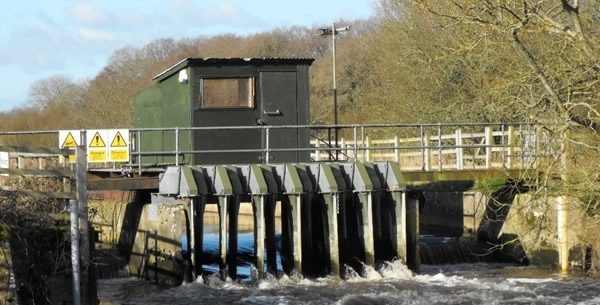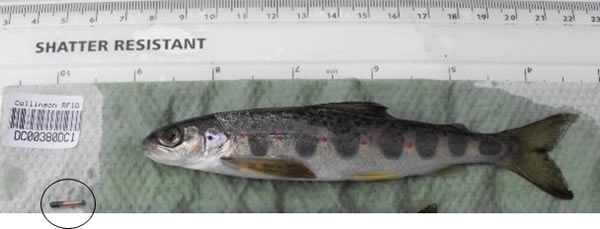
By Bill Beaumont, GWCT Senior Fisheries Scientist
In November 2003 a series of vertical vanes complete with an air-ram lifting system was installed at the East Stoke salmon counter. This unique piece of equipment housed an antenna that detected the passage of miniature Passive Integrated transponder (PIT) tags. The PIT tags (just 12 mm long x 2 mm wide as shown below) are inserted into salmon parr and enable us to identify individual fish when they swim past any of our antenna readers.

Information from these tags enabled the Fisheries team to start estimating the numbers of salmon parr in the river in the previous autumn, the numbers of salmon smolts leaving the river and (by detecting return tagged adult salmon) the sea survival of the smolts. The equipment was the first of its kind to be installed in a river for fish population monitoring and for the past 15-years has been giving us unparalleled information on the salmon population of the river Frome.
As with all technology, eventually newer systems are developed with better, quicker, cheaper capacity. Thus, in 2014 a new antenna system was installed at the fish counter (funded from the EU MOREFISH project). This new system did not have the high maintenance requirement of the vanes and had a much better detection range, enabling fewer antenna to be needed.
The new system also required that we change the type of tag that we used, which also meant that it would not read the old tags. With tagged fish still at sea we therefore needed to run the ‘old’ system until all these fish had returned. On 27th March 2018 we decided that that had happened, and the vanes were raised for the last time. Full decommissioning will take place shortly.
The SAMARCH Project – Improving the way we manage salmon and sea trout in our estuaries and coastal waters
We know that 95% of our salmon and sea trout die at sea after leaving our rivers as juveniles, called smolts. This compares to only 75% in the 1970’s and this is the main reason why the number of adults returning to our rivers has declined so dramatically in recent years.
However, it is not known what proportion of this mortality occurs in our estuaries and coastal waters compared to the open sea.
By using small acoustic tags implanted into salmon and sea trout smolts and the strategic deployment of receivers in the Frome and Tamar estuaries, our new EU project called SAMARCH will provide scientific evidence to answer this key question.
Each tag costs £250 and each receiver costs £1,200. We are using 480 tags and 25 receivers with the EU contributing 69% of the cost. Therefore, we are seeking contributions of £78 and £372 towards the cost a tag and receiver respectively.
Please support the project and help us reverse this alarming decline.
Donate here >